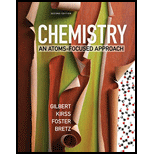
To find:
a. Whether the volume of gases collected can be used to distinguish the pathways of two reactions.
b. If the gas produced during thermal decomposition is
Answer to Problem 10.136QA
Solution:
a. The volume of gases collected can be used to distinguish the pathways of two reactions.
b. The gas produced during the thermal decomposition is
Explanation of Solution
Explanation: 1) Concept:
a. The given two decomposition reactions at two different temperatures produce different number of moles of products. Using this information, we can say that the volume of gases collected can be used to distinguish the pathways of two reactions.
b. As the gaseous products are collected over water, we can get the number of moles of gaseous products
2) Formula:
Reactions:
For part b)
i)
ii)
iii)
iv)
v)
4) Calculations:
a. The decomposition of ammonium nitrate at
b. Finding which gas is produced.
Calculation for moles of
For first reaction, the number of gaseous moles
Therefore, volume calculation for first reaction is
For second reaction,
Therefore, volume calculation for second reaction is
Second reaction’s volume is nearly the same as the given volume. Therefore, the gas produced is
Conclusion:
a. The number of the gaseous moles of the product are different for both the reaction. So we can say that their volumes collected can be used to distinguish their pathways.
b. The volume of the product produced by the given amount of ammonium nitrate can help to get which gas is produced.
Want to see more full solutions like this?
Chapter 10 Solutions
Chemistry: An Atoms-Focused Approach (Second Edition)
 ChemistryChemistryISBN:9781305957404Author:Steven S. Zumdahl, Susan A. Zumdahl, Donald J. DeCostePublisher:Cengage Learning
ChemistryChemistryISBN:9781305957404Author:Steven S. Zumdahl, Susan A. Zumdahl, Donald J. DeCostePublisher:Cengage Learning ChemistryChemistryISBN:9781259911156Author:Raymond Chang Dr., Jason Overby ProfessorPublisher:McGraw-Hill Education
ChemistryChemistryISBN:9781259911156Author:Raymond Chang Dr., Jason Overby ProfessorPublisher:McGraw-Hill Education Principles of Instrumental AnalysisChemistryISBN:9781305577213Author:Douglas A. Skoog, F. James Holler, Stanley R. CrouchPublisher:Cengage Learning
Principles of Instrumental AnalysisChemistryISBN:9781305577213Author:Douglas A. Skoog, F. James Holler, Stanley R. CrouchPublisher:Cengage Learning Organic ChemistryChemistryISBN:9780078021558Author:Janice Gorzynski Smith Dr.Publisher:McGraw-Hill Education
Organic ChemistryChemistryISBN:9780078021558Author:Janice Gorzynski Smith Dr.Publisher:McGraw-Hill Education Chemistry: Principles and ReactionsChemistryISBN:9781305079373Author:William L. Masterton, Cecile N. HurleyPublisher:Cengage Learning
Chemistry: Principles and ReactionsChemistryISBN:9781305079373Author:William L. Masterton, Cecile N. HurleyPublisher:Cengage Learning Elementary Principles of Chemical Processes, Bind...ChemistryISBN:9781118431221Author:Richard M. Felder, Ronald W. Rousseau, Lisa G. BullardPublisher:WILEY
Elementary Principles of Chemical Processes, Bind...ChemistryISBN:9781118431221Author:Richard M. Felder, Ronald W. Rousseau, Lisa G. BullardPublisher:WILEY





